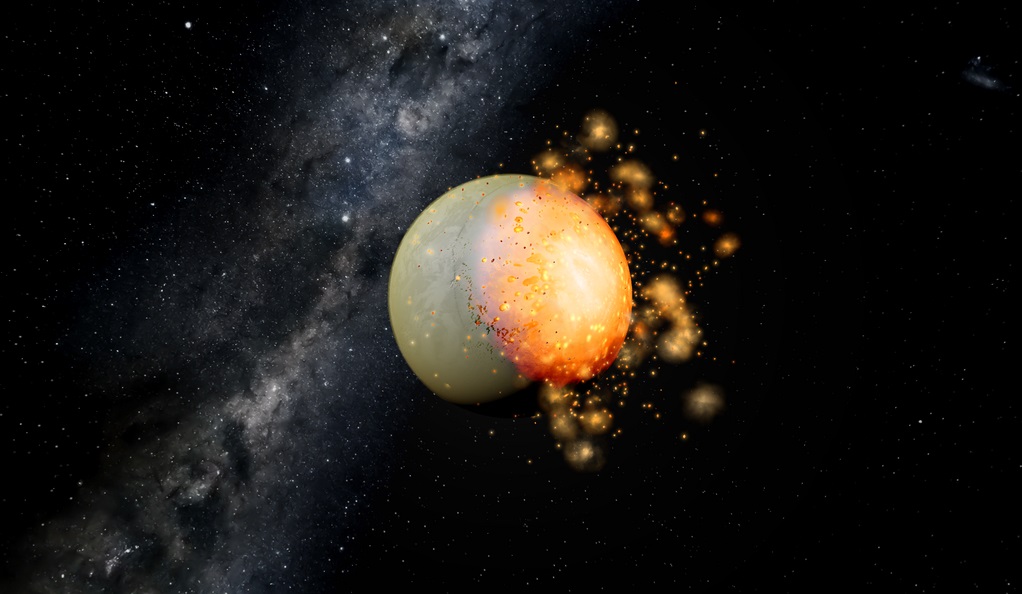Venus and Earth have several things in common. Both are terrestrial planets composed of silicate minerals and metals that are differentiated between a rocky mantle and crust and a metal core. Like Earth, Venus orbits within our Sun’s circumsolar habitable zone (HZ), though Venus skirts the inner edge of it. And according to a growing body of evidence, Venus has active volcanoes on its surface that contribute to atmospheric phenomena (like lightning). However, that’s where the similarities end, and some rather stark differences set in.
In addition to Venus’ hellish atmosphere, which is about 100 times as dense as Earth’s and hot enough to melt lead, Venus has a very “youthful” surface. Compared to other bodies in the Solar System (like Mercury, the Moon, and Mars), Venus’ surface retains little evidence of the many bolides impacts it experienced over billions of years. According to new research from the Southwest Research Institute (SwRI) and Yale University, this may result from bolide impacts that provided a high-energy, rejuvenating boost to the planet in its early years.
The research was conducted by Simone Marchi, a staff scientist at the SwRI who specializes in planetary formation and the geology of asteroids and terrestrial planets. He was joined by Raluca Rufu, a postdoctoral researcher of space sciences at SwRI, and Jun Korenaga, a professor of Earth and planetary sciences at Yale University. The paper that describes their research, “Long-lived volcanic resurfacing of Venus driven by early collisions,” recently appeared in Nature Astronomy.
Thanks to missions like the Magellan probe and the extensive radar mapping it conducted in the 1990s, scientists began mapping the surface of Venus in detail. To their surprise, the surface appeared far smoother than expected, which suggested that a certain mechanism was responsible for “recycling” the surface. On Earth, impact craters are largely removed by resurfacing events caused by tectonic activity, but Venus has no such activity to explain its smooth features. Said Professor Korenaga in a Yale News release:
“We would expect Venus to be heavily cratered, but surprisingly, it is much less cratered than the moon or Mars. Many scientists have tried to explain this young surface age of Venus. One popular idea is that Venus used to have plate tectonics, but somehow it stopped about 500 million years ago. This explanation is admittedly ad hoc, so others have tried to come up with models that are physically more sound, with limited success.”
For their study, Marchi, Rufu, and Korenaga considered the possibility that Venus experienced more powerful bolide impacts than Earth during the Hadean period (ca. 4.5 billion years ago). At this time, the newly-formed planets experienced a high rate of high-magnitude impacts due to the abundance of leftover material floating around space. Similarly, astronomers have noted another period of intense bombardment between 4.1 and 3.8 billion years ago known as the Late Heavy Bombardment. This period is attributed to planetary instability, possibly involving the migration of the gas giants.
Over time, the intensity of the bombardment declined as the planets achieved more stable orbits. While Earth and Venus formed in the same general area of the inner Solar System, the differences in their distances from the Sun mean that they have different impact histories – i.e., the number of impacts and their outcomes were slightly different. “One of the mysteries of the inner solar system is that, despite their similar size and bulk density, Earth and Venus operate in strikingly different ways, particularly affecting the processes that move materials through a planet,” explained Marchi.

To test this theory, the team ran simulations of Venus experiencing more systemic bolide impacts billions of years ago. These revealed a trend where successive impacts blasted deeper into Venus, leading to the superheating of the planet’s core. Said Korenaga, this would account for higher than normal volcanic activity, which could explain why the surface appears young and uncratered:
“This superheated core could have a long-lasting influence on the volcanic history of Venus It could keep heating up the mantle for a few billion years, with sufficient volcanic activity to cover up most of the craters and reduce the apparent surface age to only a few hundred million years.”
The team looks forward to upcoming missions that will explore Venus in the coming years and provide insight into the planet’s tectonic and bolide impact history (allowing them to test their theory). These include NASA’s Venus Emissivity, Radio science, InSAR, Topography, And Spectroscopy (VERITAS) and Deep Atmosphere Venus Investigation of Noble gases, Chemistry, and Imaging (DAVINCI) mission, scheduled to launch by 2027 and 2029 (respectively). They will be joined by the ESA/NASA EnVision satellite by the early 2030s.
These missions will perform atmospheric studies and high-resolution radar mapping of Venus’ surface, building on the work of previous missions – like the Soviet Venera Program, NASA’s Pioneer Venus and Magellan missions, and the ESA’s Venus Express – and delivering deeper into the mysteries and evolutionary history of “Earth’s Sister Planet.”
Further Reading: YaleNews

